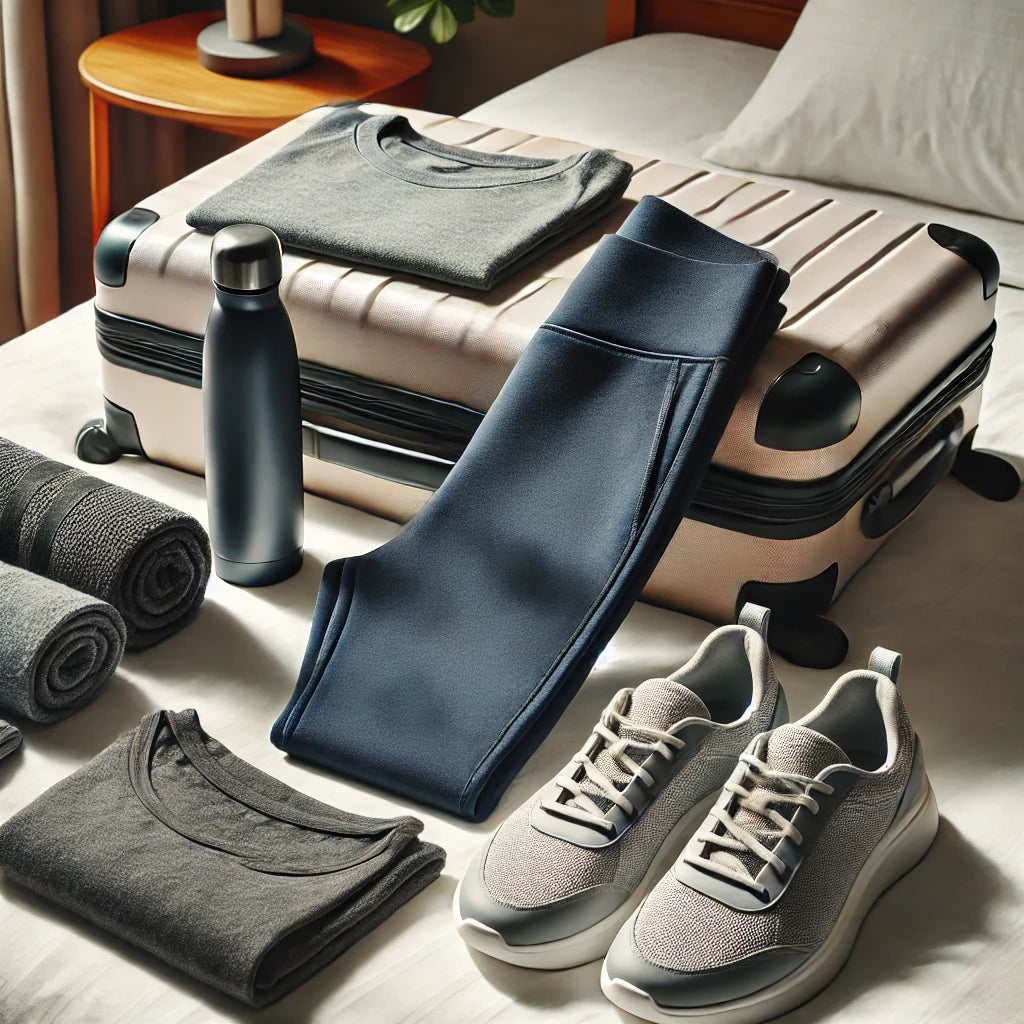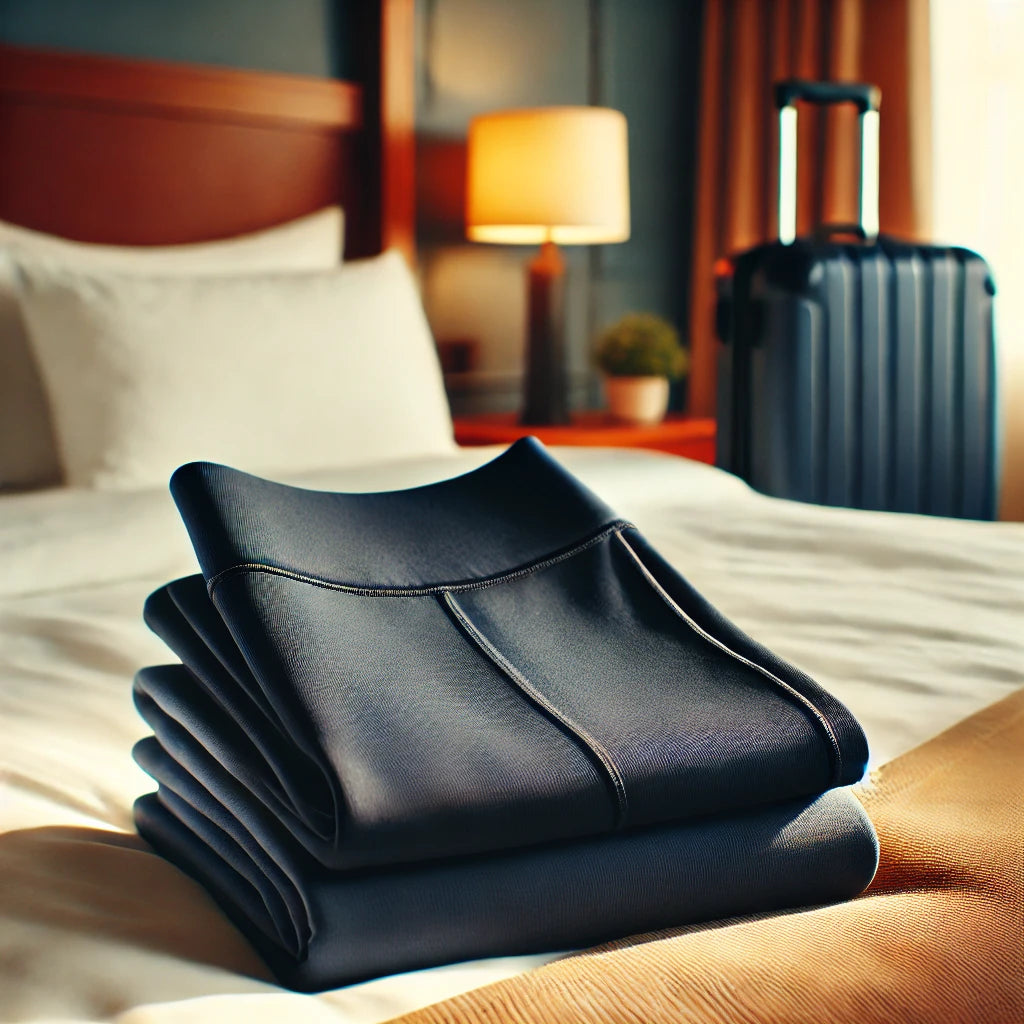In today's fast-paced world, finding time to maintain a fitness routine can be challenging, especially for busy professionals who are constantly on the go. However, staying fit doesn't have to be a time-consuming endeavor. With efficient 3-day workout plans tailored for the demanding schedules of traveling professionals, you can achieve your fitness goals without compromising your work commitments. These workout plans are designed to maximize results in minimal time, utilizing dumbbells and compact spaces like hotel rooms or small gyms. Whether you're a pilot, flight attendant, or travel nurse, these effective routines will help you stay in shape, boost your energy, and improve your overall well-being, no matter where your travels take you.

Why Choose a 3-Day Workout Plan?
For many traveling professionals, a traditional five or six-day workout schedule isn't feasible. A 3-day workout plan offers several advantages:
- Flexibility: It provides the flexibility to fit workouts into a busy travel schedule.
- Efficiency: Focuses on high-intensity, full-body exercises that yield maximum results.
- Recovery: Allows ample time for muscle recovery, reducing the risk of injury and burnout.
A well-structured 3-day workout plan ensures you stay active, maintain muscle mass, and improve cardiovascular health without spending hours in the gym.
Designing an Effective 3-Day Workout Plan
When designing a 3-day workout plan, it's essential to focus on exercises that target multiple muscle groups and promote overall fitness. Here’s a breakdown of how to structure your workouts:
Day 1: Full-Body Strength Training
Objective: Build and maintain muscle mass while enhancing overall strength.
Warm-Up (10 minutes):
- Jumping jacks: 2 minutes
- Dynamic stretches (leg swings, arm circles): 3 minutes
- Bodyweight squats: 2 minutes
- High knees: 2 minutes
- Push-ups: 1 minute
Workout:
- Dumbbell Squats: 4 sets of 12 reps
- Engage your core and keep your back straight. Hold a dumbbell in each hand, lower into a squat, and push back up to the starting position.
- Dumbbell Bench Press: 4 sets of 12 reps
- Lie on a flat surface, hold a dumbbell in each hand, and press the weights upwards until your arms are fully extended.
- Bent-Over Dumbbell Rows: 4 sets of 12 reps
- Hinge at your hips, keep your back straight, and pull the dumbbells towards your waist.
- Dumbbell Lunges: 3 sets of 15 reps per leg
- Step forward with one leg, lower your hips until both knees are bent at about a 90-degree angle, and push back up.
- Dumbbell Shoulder Press: 4 sets of 12 reps
- Stand or sit with a straight back, hold the dumbbells at shoulder height, and press them overhead.
- Plank Dumbbell Rows: 3 sets of 15 reps per arm
- Get into a plank position, row one dumbbell at a time towards your hip while maintaining a straight body line.
Cool-Down (10 minutes):
- Static stretching: Focus on the legs, arms, and back.
- Deep breathing exercises to lower the heart rate.
Day 2: Cardiovascular and Core Workout
Objective: Enhance cardiovascular endurance and strengthen core muscles.
Warm-Up (10 minutes):
- Light jogging or brisk walking: 5 minutes
- Dynamic stretches (hip circles, torso twists): 3 minutes
- Jump rope: 2 minutes
Workout:
- High-Intensity Interval Training (HIIT): 20 minutes
- Alternate between 30 seconds of high-intensity exercise (burpees, mountain climbers, sprinting in place) and 30 seconds of rest.
- Dumbbell Russian Twists: 3 sets of 20 reps
- Sit on the floor with your knees bent, lean back slightly, hold a dumbbell with both hands, and twist your torso from side to side.
- Dumbbell Sit-Ups: 3 sets of 15 reps
- Lie on your back with your knees bent, hold a dumbbell to your chest, and perform sit-ups.
- Dumbbell Side Plank Raises: 3 sets of 15 reps per side
- Get into a side plank position, hold a dumbbell in the free hand, and lift your hips towards the ceiling.
- Dumbbell Bicycle Crunches: 3 sets of 20 reps
- Lie on your back, hold a dumbbell in each hand, and perform bicycle crunches.
- Jump Rope: 5 minutes
- Focus on maintaining a steady rhythm and proper form.
Cool-Down (10 minutes):
- Static stretching: Emphasize the core and legs.
- Meditation or deep breathing exercises.
Day 3: Upper and Lower Body Split
Objective: Focus on isolating upper and lower body muscle groups to ensure balanced development.
Warm-Up (10 minutes):
- Arm circles and shoulder rolls: 3 minutes
- Bodyweight lunges: 3 minutes
- Light jogging or jumping jacks: 4 minutes
Workout:
- Dumbbell Deadlifts: 4 sets of 12 reps
- Keep your back straight, hinge at your hips, and lift the dumbbells from the ground to a standing position.
- Dumbbell Chest Flyes: 4 sets of 12 reps
- Lie on a flat surface, hold the dumbbells above your chest, and lower them out to the sides, then bring them back together.
- Dumbbell Step-Ups: 3 sets of 15 reps per leg
- Step onto a stable platform or bench with one leg, lift your body up, and step back down.
- Dumbbell Bicep Curls: 4 sets of 12 reps
- Stand with your feet shoulder-width apart, hold a dumbbell in each hand, and curl the weights towards your shoulders.
- Dumbbell Tricep Extensions: 4 sets of 12 reps
- Hold a dumbbell with both hands, lift it overhead, and lower it behind your head, then extend your arms back up.
- Dumbbell Calf Raises: 3 sets of 20 reps
- Stand with your feet hip-width apart, hold a dumbbell in each hand, and raise your heels off the ground.
Cool-Down (10 minutes):
- Static stretching: Focus on arms, legs, and back.
- Deep breathing exercises to promote relaxation.
Tips for Staying Motivated
Staying committed to a workout routine while traveling can be tough. Here are some tips to keep you motivated:
- Set Realistic Goals: Establish achievable fitness goals to stay focused and motivated.
- Track Progress: Use a fitness journal or app to track your workouts and progress.
- Stay Accountable: Partner with a colleague or join online fitness communities for support and accountability.
- Reward Yourself: Celebrate milestones with small rewards to stay motivated.
- Stay Flexible: Adapt your workout plans to accommodate travel schedules and unexpected changes.
Nutrition Tips for Traveling Professionals
Alongside your workout routine, maintaining a healthy diet is crucial. Here are some nutrition tips for busy professionals on the go:
- Plan Ahead: Pack healthy snacks like nuts, fruits, and protein bars.
- Stay Hydrated: Carry a water bottle and aim to drink at least 8 glasses of water a day.
- Balanced Meals: Focus on balanced meals with lean proteins, whole grains, and plenty of vegetables.
- Avoid Fast Food: Opt for healthier options at restaurants, such as salads, grilled proteins, and vegetable sides.
- Moderation: Enjoy treats in moderation to avoid feeling deprived.
Equipment for On-the-Go Workouts
Having the right equipment can make your workouts more effective and enjoyable. Here are some portable workout essentials:
- Dumbbells: A set of adjustable dumbbells can accommodate various exercises and weight levels.
- Resistance Bands: Lightweight and versatile, resistance bands are great for strength training and stretching.
- Jump Rope: Perfect for cardiovascular workouts, a jump rope is compact and easy to carry.
- Yoga Mat: Provides a comfortable surface for floor exercises and stretching.
- Foam Roller: Useful for post-workout muscle recovery and relaxation.

Sample 3-Day Workout Plan for a Week
Here's a sample 3-day workout plan for a week, incorporating the exercises discussed:
Week 1
Day 1: Full-Body Strength Training
- Dumbbell Squats: 4 sets of 12 reps
- Dumbbell Bench Press: 4 sets of 12 reps
- Bent-Over Dumbbell Rows: 4 sets of 12 reps
- Dumbbell Lunges: 3 sets of 15 reps per leg
- Dumbbell Shoulder Press: 4 sets of 12 reps
- Plank Dumbbell Rows: 3 sets of 15 reps per arm
Day 2: Cardiovascular and Core Workout
- HIIT: 20 minutes
- Dumbbell Russian Twists: 3 sets of 20 reps
- Dumbbell Sit-Ups: 3 sets of 15 reps
- Dumbbell Side Plank Raises: 3 sets of 15 reps per side
- Dumbbell Bicycle Crunches: 3 sets of 20 reps
- Jump Rope: 5 minutes
Day 3: Upper and Lower Body Split
- Dumbbell Deadlifts: 4 sets of 12 reps
- Dumbbell Chest Flyes: 4 sets of 12 reps
- Dumbbell Step-Ups: 3 sets of 15 reps per leg
- Dumbbell Bicep Curls: 4 sets of 12 reps
- Dumbbell Tricep Extensions: 4 sets of 12 reps
- Dumbbell Calf Raises: 3 sets of 20 reps
Adjusting the Plan to Your Needs
Every individual has unique fitness needs and preferences. Here are some ways to adjust the plan:
- Intensity Levels: Modify the weight and intensity of exercises to match your fitness level.
- Exercise Selection: Substitute exercises based on available equipment or personal preference.
- Rest Periods: Adjust rest periods between sets and exercises to match your endurance levels.
- Frequency: While three days a week is effective, you can add a fourth day if your schedule allows.
Benefits of a 3-Day Workout Plan
- Time-Efficient: Fits into busy schedules without overwhelming your routine.
- Improved Recovery: Adequate rest between sessions helps prevent overtraining.
- Consistent Progress: Regular, intense workouts ensure continuous improvement.
- Versatility: Easily adaptable to different environments and available equipment.
Overcoming Common Challenges
Traveling professionals face unique challenges when it comes to maintaining a workout routine. Here are some common obstacles and strategies to overcome them:
Limited Space
Hotel rooms and small gym facilities often lack the space of a traditional gym. Here's how to make the most of limited space:
- Compact Equipment: Use equipment that doesn't take up much room, like dumbbells, resistance bands, and jump ropes.
- Bodyweight Exercises: Incorporate bodyweight exercises such as push-ups, squats, lunges, and planks.
- Furniture Utilization: Use furniture like chairs and beds for exercises like tricep dips and incline push-ups.
Unpredictable Schedules
Frequent travel can lead to irregular schedules, making it hard to stick to a consistent workout routine. Here are some tips:
- Plan Ahead: Look at your schedule ahead of time and find pockets where you can fit in your workouts.
- Be Flexible: Adapt your workout times and lengths to fit around your commitments. A shorter, high-intensity workout can be just as effective.
- Workout Early: Try to exercise first thing in the morning before your day gets too busy.
Lack of Motivation
Maintaining motivation can be difficult, especially when you're traveling alone. Here are some strategies to stay motivated:
- Set Small Goals: Break down your larger fitness goals into smaller, more manageable targets.
- Use Technology: Fitness apps can help track progress, set reminders, and provide workout ideas.
- Join Online Communities: Participate in online fitness groups or forums for support and accountability.
Recovery and Rest
Recovery is a crucial component of any workout plan, especially for those constantly on the go. Here’s how to ensure you’re getting adequate rest and recovery:
Importance of Sleep
Sleep is essential for muscle recovery and overall health. Traveling professionals should prioritize good sleep hygiene:
- Consistent Schedule: Try to go to bed and wake up at the same time every day, even on weekends.
- Sleep Environment: Create a sleep-friendly environment by keeping your room dark, quiet, and cool.
- Limit Caffeine: Avoid caffeine and heavy meals close to bedtime to improve sleep quality.
Active Recovery
Active recovery involves low-intensity activities that help to promote blood flow and muscle recovery:
- Light Exercises: Engage in light exercises such as walking, yoga, or stretching on rest days.
- Foam Rolling: Use a foam roller to relieve muscle tightness and improve flexibility.
- Hydration: Stay well-hydrated to aid in the recovery process and prevent muscle cramps.
Advanced Techniques for Maximizing Results
For those who want to take their workouts to the next level, consider incorporating advanced techniques into your routine:
Supersets
Supersets involve performing two exercises back-to-back with no rest in between. This can save time and increase workout intensity:
- Antagonistic Supersets: Pair exercises that target opposing muscle groups, such as bicep curls and tricep extensions.
- Agonistic Supersets: Pair exercises that target the same muscle group, such as bench press and push-ups.
Drop Sets
Drop sets involve performing an exercise until failure, then reducing the weight and continuing until failure again. This technique helps to build muscle endurance and strength:
- Example: Start with a heavy set of dumbbell curls until failure, then immediately switch to a lighter weight and continue.
Pyramid Sets
Pyramid sets gradually increase the weight with each set, then decrease it. This method can enhance muscle strength and hypertrophy:
- Example: Perform a set of squats with a light weight, then increase the weight for each subsequent set until reaching your maximum, and then decrease the weight.
Nutrition on the Go
Maintaining a healthy diet while traveling can be challenging but is essential for supporting your workout routine. Here are some tips for eating well on the go:
Balanced Meals
Aim for balanced meals that include a mix of proteins, carbohydrates, and healthy fats:
- Lean Proteins: Choose sources like chicken, fish, tofu, and legumes.
- Complex Carbs: Opt for whole grains, vegetables, and fruits.
- Healthy Fats: Incorporate avocados, nuts, seeds, and olive oil.
Meal Prep
Meal prepping can save time and ensure you have healthy options available:
- Plan Ahead: Prepare meals or snacks before your trip.
- Healthy Snacks: Pack portable, healthy snacks like nuts, fruits, and protein bars.
- Use Apps: Utilize food delivery apps to find healthy restaurant options.
Hydration
Staying hydrated is vital for overall health and workout performance:
- Water Intake: Aim to drink at least 8 glasses of water a day, more if you’re active or in a hot climate.
- Electrolytes: Consider electrolyte supplements if you’re sweating a lot.
- Limit Sugary Drinks: Avoid sugary drinks and opt for water, herbal teas, or diluted fruit juices.

Mental Health and Fitness
Physical fitness is closely linked to mental health. Here are some ways to ensure you’re taking care of both:
Stress Management
Traveling and a busy work schedule can lead to increased stress. Here are some strategies to manage stress:
- Mindfulness: Practice mindfulness or meditation to reduce stress and improve focus.
- Breathing Exercises: Use deep breathing exercises to calm the mind and body.
- Leisure Activities: Engage in activities you enjoy to relax and unwind.
Work-Life Balance
Maintaining a balance between work and personal life is crucial for mental well-being:
- Set Boundaries: Establish clear boundaries between work and personal time.
- Prioritize Self-Care: Make time for activities that you enjoy and that relax you.
- Seek Support: Don’t hesitate to seek support from friends, family, or professionals if you’re feeling overwhelmed.
Long-Term Fitness Goals
Setting and achieving long-term fitness goals requires planning and dedication. Here’s how to stay on track:
Goal Setting
- SMART Goals: Set Specific, Measurable, Achievable, Relevant, and Time-bound goals.
- Short-Term vs. Long-Term: Break down long-term goals into shorter, achievable milestones.
- Adjust as Needed: Be flexible and adjust your goals based on progress and changes in your schedule.
Tracking Progress
- Fitness Journal: Keep a journal to record workouts, progress, and how you feel.
- Apps and Gadgets: Use fitness apps or gadgets to monitor your progress and stay motivated.
- Regular Check-Ins: Regularly review and assess your progress towards your goals.
Rewarding Yourself
- Milestone Rewards: Treat yourself when you reach significant milestones.
- Non-Food Rewards: Choose rewards that aren’t food-related, like new workout gear or a massage.
- Celebrate Successes: Take time to celebrate your successes, no matter how small.
Common Mistakes to Avoid
To make the most of your 3-day workout plan, be aware of common mistakes and how to avoid them:
Overtraining
Overtraining can lead to injuries and burnout. Ensure you’re allowing adequate recovery time:
- Listen to Your Body: Pay attention to signs of fatigue and soreness.
- Rest Days: Incorporate rest days into your routine to allow for recovery.
- Variety: Mix up your workouts to avoid overworking the same muscle groups.
Poor Form
Using improper form can lead to injuries and reduce the effectiveness of your workouts:
- Focus on Technique: Prioritize proper form over lifting heavier weights.
- Use Mirrors: If available, use mirrors to monitor and correct your form.
- Professional Guidance: Consider working with a trainer to ensure you’re using the correct techniques.
Skipping Warm-Ups and Cool-Downs
Skipping warm-ups and cool-downs can increase the risk of injury and reduce recovery:
- Warm-Up: Always include a 5-10 minute warm-up to prepare your muscles and joints.
- Cool-Down: Spend 5-10 minutes cooling down with light activity and stretching.
- Stretching: Incorporate both dynamic stretching in the warm-up and static stretching in the cool-down.
Staying Consistent
Consistency is key to achieving and maintaining fitness goals. Here are some strategies to stay consistent:
Routine Building
- Set a Schedule: Plan your workouts for the same days and times each week.
- Habit Stacking: Pair your workout with an existing habit to make it more automatic.
- Travel Adjustments: Be prepared to adapt your routine to fit travel schedules.
Accountability
- Workout Buddy: Partner with a friend or colleague to keep each other accountable.
- Online Communities: Join online fitness communities for support and motivation.
- Progress Sharing: Share your goals and progress with others to stay accountable.
Tailoring Workouts for Different Travel Scenarios
Traveling professionals often find themselves in various environments, each with its own set of challenges and opportunities for fitness. Here’s how to tailor your 3-day workout plan to different travel scenarios:
Hotel Rooms
Hotel rooms can be limited in space and equipment. Here’s how to adapt:
- Space Utilization: Use the available space wisely. Exercises like bodyweight squats, push-ups, and planks can be done in even the smallest rooms.
- Portable Equipment: Bring along portable fitness equipment like resistance bands and adjustable dumbbells.
- Furniture Hacks: Use chairs for tricep dips or beds for incline push-ups.
Hotel Gyms
Many hotels have small fitness centers. Make the most of these facilities:
- Assess Equipment: Upon arrival, check what equipment is available (e.g., dumbbells, benches, treadmills).
- Combine Cardio and Strength: Use available machines for a combination of cardio and strength workouts.
- Adaptable Plans: Adjust your workout plan to incorporate available equipment and space.
Airports and Long Layovers
Long layovers can be an opportunity to squeeze in a workout:
- Airport Gyms: Some airports have gyms or wellness centers. Plan ahead and use these facilities if available.
- Bodyweight Exercises: Find a quiet corner to perform bodyweight exercises like lunges, squats, and calf raises.
- Stretching and Mobility: Utilize downtime to stretch and improve mobility with simple exercises like neck rolls and hip circles.
Outdoors
If you’re staying in a location with good weather, take advantage of outdoor spaces:
- Parks and Trails: Look for nearby parks or trails for jogging, walking, or outdoor circuits.
- Beach Workouts: If you’re near a beach, incorporate exercises like beach runs or bodyweight circuits on the sand.
- Stairs and Hills: Utilize stairs or hills for high-intensity interval training (HIIT) or stair runs.
Incorporating Variations and Progressions
To keep your workouts challenging and prevent plateaus, it’s essential to incorporate variations and progressions:
Exercise Variations
Switching up your exercises can keep your workouts interesting and target muscles in different ways:
- Squat Variations: Try goblet squats, split squats, or jump squats.
- Push-Up Variations: Experiment with incline push-ups, decline push-ups, or clap push-ups.
- Core Variations: Incorporate different core exercises like leg raises, flutter kicks, or hanging leg raises.
Progressive Overload
To build strength and muscle, progressively increase the intensity of your workouts:
- Increase Weight: Gradually increase the weight of your dumbbells as you get stronger.
- Add Reps: Add more repetitions to your sets to increase endurance.
- Reduce Rest Time: Decrease rest time between sets to increase intensity.
Circuit Training
Circuit training involves performing a series of exercises with minimal rest in between. This can be particularly effective for busy travelers:
- Full-Body Circuits: Design a circuit that targets all major muscle groups. For example, squats, push-ups, dumbbell rows, and planks.
- Timed Circuits: Perform each exercise for a set time (e.g., 45 seconds) followed by a short rest (e.g., 15 seconds).
- AMRAP Circuits: "As Many Rounds As Possible" circuits challenge you to complete as many rounds of a set circuit as possible within a specific time.

Sample Workouts
Here are some detailed sample workouts to help you get started:
Sample Full-Body Strength Training (Day 1)
Warm-Up:
- Jumping jacks: 2 minutes
- Dynamic stretches: 3 minutes
- Bodyweight squats: 2 minutes
- High knees: 2 minutes
- Push-ups: 1 minute
Workout:
- Dumbbell Squats: 4 sets of 12 reps
- Tips: Keep your back straight and core engaged. Hold dumbbells at your sides or on your shoulders.
- Dumbbell Bench Press: 4 sets of 12 reps
- Tips: Ensure full range of motion. Lower weights slowly and push up explosively.
- Bent-Over Dumbbell Rows: 4 sets of 12 reps
- Tips: Keep your back flat and pull dumbbells towards your waist.
- Dumbbell Lunges: 3 sets of 15 reps per leg
- Tips: Step forward, keeping your knee behind your toes. Alternate legs each rep.
- Dumbbell Shoulder Press: 4 sets of 12 reps
- Tips: Press dumbbells overhead, keeping your core tight.
- Plank Dumbbell Rows: 3 sets of 15 reps per arm
- Tips: Maintain a plank position while rowing a dumbbell towards your hip.
Cool-Down:
- Static stretching: 10 minutes (focus on legs, arms, and back)
- Deep breathing exercises: 2-3 minutes
Sample Cardiovascular and Core Workout (Day 2)
Warm-Up:
- Light jogging or brisk walking: 5 minutes
- Dynamic stretches: 3 minutes
- Jump rope: 2 minutes
Workout:
- HIIT: 20 minutes
- Example: 30 seconds burpees, 30 seconds rest; 30 seconds mountain climbers, 30 seconds rest.
- Dumbbell Russian Twists: 3 sets of 20 reps
- Tips: Keep your feet off the ground and twist your torso side to side.
- Dumbbell Sit-Ups: 3 sets of 15 reps
- Tips: Hold a dumbbell to your chest and perform a sit-up.
- Dumbbell Side Plank Raises: 3 sets of 15 reps per side
- Tips: Hold a side plank position while lifting your hips.
- Dumbbell Bicycle Crunches: 3 sets of 20 reps
- Tips: Alternate bringing your elbow to the opposite knee while holding a dumbbell.
- Jump Rope: 5 minutes
- Tips: Maintain a steady rhythm and proper form.
Cool-Down:
- Static stretching: 10 minutes (focus on core and legs)
- Meditation or deep breathing exercises: 2-3 minutes
Sample Upper and Lower Body Split (Day 3)
Warm-Up:
- Arm circles and shoulder rolls: 3 minutes
- Bodyweight lunges: 3 minutes
- Light jogging or jumping jacks: 4 minutes
Workout:
- Dumbbell Deadlifts: 4 sets of 12 reps
- Tips: Keep your back straight and hinge at your hips.
- Dumbbell Chest Flyes: 4 sets of 12 reps
- Tips: Lower dumbbells to the side with a slight bend in your elbows.
- Dumbbell Step-Ups: 3 sets of 15 reps per leg
- Tips: Step onto a stable surface and alternate legs.
- Dumbbell Bicep Curls: 4 sets of 12 reps
- Tips: Keep your elbows close to your body and curl weights up.
- Dumbbell Tricep Extensions: 4 sets of 12 reps
- Tips: Lower dumbbells behind your head and extend your arms.
- Dumbbell Calf Raises: 3 sets of 20 reps
- Tips: Stand with dumbbells and raise your heels off the ground.
Cool-Down:
- Static stretching: 10 minutes (focus on arms, legs, and back)
- Deep breathing exercises: 2-3 minutes
Traveling Nutrition Tips in Detail
Proper nutrition is vital for energy and recovery, especially for traveling professionals. Here’s a more detailed look at maintaining a balanced diet on the go:
Planning Meals
- Meal Prepping: Prepare and pack meals in advance. Use containers that keep food fresh.
- Healthy Choices: Choose meals that are high in protein, low in unhealthy fats, and rich in vegetables.
- Portable Snacks: Carry snacks like nuts, seeds, dried fruits, and protein bars.
Eating Out
When dining out, it’s still possible to make healthy choices:
- Research Restaurants: Look up menus online before visiting to find healthy options.
- Ask for Modifications: Don’t hesitate to ask for changes, like dressing on the side or grilled instead of fried.
- Portion Control: Be mindful of portion sizes. Consider sharing dishes or asking for half portions.
Hydration Strategies
Staying hydrated is crucial, especially when traveling:
- Carry a Water Bottle: Always have a refillable water bottle with you.
- Set Reminders: Use your phone to set hydration reminders throughout the day.
- Electrolyte Balance: Incorporate drinks that replenish electrolytes, especially after intense workouts.
Managing Jet Lag and Nutrition
Traveling across time zones can disrupt your eating schedule and digestion:
- Adjust Eating Times: Gradually adjust your meal times to the new time zone a few days before travel.
- Healthy Snacks: Keep healthy snacks on hand to avoid unhealthy airport food.
- Stay Hydrated: Drink plenty of water before, during, and after flights.
Mental Health and Its Impact on Fitness
Mental health plays a crucial role in maintaining a fitness routine. Here’s how to ensure your mental well-being while traveling:
Stress Reduction Techniques
- Mindfulness Meditation: Practice mindfulness or meditation daily to reduce stress.
- Breathing Exercises: Incorporate deep breathing exercises into your routine.
- Journaling: Write down your thoughts and feelings to help manage stress.
Building a Support System
- Stay Connected: Keep in touch with family and friends while traveling.
- Online Communities: Join fitness or travel forums for support and motivation.
- Professional Help: Don’t hesitate to seek help from a therapist if needed.
Long-Term Strategies for Sustainable Fitness
Maintaining long-term fitness requires a combination of consistency, adaptability, and motivation. Here’s how to ensure your fitness journey is sustainable:
Creating a Sustainable Routine
- Realistic Goals: Set realistic and achievable fitness goals.
- Adaptability: Be ready to adapt your routine based on your schedule and environment.
- Enjoyment: Find workouts that you enjoy to keep motivation high.
Tracking and Celebrating Progress
- Regular Assessments: Regularly assess your progress and adjust goals as needed.
- Visual Progress: Take photos or videos to visually track your progress.
- Celebrate Milestones: Reward yourself when you reach significant fitness milestones.
Continuous Learning
- Stay Informed: Keep up with the latest fitness and nutrition research.
- Experiment: Don’t be afraid to try new exercises, routines, or diets.
- Feedback: Listen to your body and adjust your routine based on how you feel.

Building a Fitness-Friendly Lifestyle
Creating an environment and lifestyle that supports your fitness goals is essential:
Home Environment
- Home Gym: Set up a small home gym with essential equipment like dumbbells and resistance bands.
- Healthy Pantry: Stock your kitchen with healthy food options.
- Active Habits: Incorporate physical activity into your daily routine, like taking the stairs or walking instead of driving.
Work Environment
- Ergonomic Setup: Ensure your work environment is ergonomic to prevent strain and injury.
- Active Breaks: Take regular breaks to stretch or walk around.
- Healthy Eating: Keep healthy snacks at work and avoid the office vending machine.
Fitness Tracking and Technology
Incorporating technology into your fitness routine can help you stay motivated, track your progress, and ensure you’re meeting your goals. Here’s how to use technology effectively:
Fitness Apps
There are numerous apps available that can enhance your workout routine:
- Workout Plans: Apps like MyFitnessPal, Nike Training Club, and JEFIT provide structured workout plans and tracking.
- Activity Tracking: Apps like Strava, MapMyRun, and Fitbit track your daily activity, including steps, calories burned, and distance covered.
- Progress Monitoring: Use apps to log workouts, track progress, and set fitness goals.
Wearable Technology
Wearable devices can offer real-time data and insights into your fitness:
- Fitness Trackers: Devices like Fitbit, Garmin, and Apple Watch monitor heart rate, steps, sleep patterns, and workout intensity.
- Smartwatches: Many smartwatches come with built-in fitness tracking features and can sync with fitness apps.
- Heart Rate Monitors: Using a heart rate monitor during workouts can help ensure you’re training at the right intensity.
Online Communities and Virtual Training
Joining online communities or participating in virtual training sessions can provide support and accountability:
- Virtual Classes: Platforms like Peloton, Beachbody On Demand, and Zwift offer live and on-demand classes for various workouts.
- Fitness Forums: Engage with fitness forums and social media groups to share experiences, seek advice, and stay motivated.
- Personal Trainers: Consider hiring a virtual personal trainer for customized workout plans and guidance.
Customizing Your 3-Day Workout Plan
While a standard 3-day workout plan is effective, customizing it to fit your specific needs and preferences can enhance its effectiveness:
Fitness Goals
Tailor your workout plan based on your primary fitness goals:
- Weight Loss: Focus on high-intensity interval training (HIIT) and cardio combined with strength training.
- Muscle Gain: Emphasize strength training with progressive overload and sufficient protein intake.
- Endurance: Incorporate longer cardio sessions and endurance-focused strength training.
Fitness Level
Adjust the intensity and complexity of exercises based on your fitness level:
- Beginners: Start with basic exercises and lighter weights, gradually increasing intensity as you build strength.
- Intermediate: Incorporate more complex movements and heavier weights to challenge your muscles.
- Advanced: Use advanced techniques like supersets, drop sets, and pyramid sets for maximum muscle stimulation.
Equipment Availability
Customize your workout plan based on the equipment you have access to:
- Minimal Equipment: Focus on bodyweight exercises, resistance bands, and a few dumbbells.
- Full Gym Access: Utilize machines, barbells, and a variety of weights for a comprehensive workout.
- Outdoor Workouts: Incorporate exercises that can be done with minimal equipment in outdoor settings.
Incorporating Flexibility and Mobility Work
Flexibility and mobility are essential components of a well-rounded fitness routine, particularly for traveling professionals who may spend long hours sitting or standing:
Stretching
Incorporate stretching exercises to improve flexibility and prevent injury:
- Dynamic Stretching: Perform dynamic stretches like leg swings, arm circles, and hip rotations during your warm-up.
- Static Stretching: Include static stretches such as hamstring stretches, quad stretches, and shoulder stretches in your cool-down.
- Yoga: Practice yoga regularly to enhance flexibility, balance, and mental relaxation.
Mobility Drills
Mobility drills can improve joint function and overall movement quality:
- Joint Circles: Perform joint circles for the neck, shoulders, hips, and ankles to improve range of motion.
- Foam Rolling: Use a foam roller to release muscle tightness and improve mobility.
- Active Isolated Stretching: Incorporate active isolated stretches to lengthen muscles and improve mobility.
Adapting to Different Environments
Traveling professionals often find themselves in varied environments, each offering unique opportunities and challenges for staying fit. Here’s how to adapt your 3-day workout plan to different settings:
Working Out in Different Climates
Adapt your workouts to suit the climate you’re in:
- Hot Climates: Stay hydrated, wear lightweight clothing, and avoid working out during peak heat hours.
- Cold Climates: Dress in layers, warm up thoroughly, and consider indoor workouts if outdoor conditions are too harsh.
- High Altitude: Give your body time to acclimate to higher altitudes, and start with lower intensity workouts.
Dealing with Jet Lag
Jet lag can disrupt your sleep and energy levels, making it challenging to maintain a workout routine:
- Adjust Gradually: Shift your sleep schedule gradually before your trip to align with the new time zone.
- Stay Active: Light exercise can help you adjust to the new time zone and reduce fatigue.
- Natural Light: Expose yourself to natural light to help regulate your body’s internal clock.
Managing Nutrition on Long Trips
Long trips can make it challenging to maintain healthy eating habits. Here’s how to manage your nutrition effectively:
Preparing for the Trip
- Plan Ahead: Research restaurants and grocery stores at your destination to find healthy options.
- Pack Snacks: Bring healthy snacks like nuts, seeds, dried fruits, and protein bars to avoid unhealthy airport or convenience store food.
- Hydration: Carry a refillable water bottle and stay hydrated throughout your journey.
Eating During Travel
- Healthy Choices: Opt for salads, grilled proteins, and vegetable sides when dining out.
- Balanced Meals: Ensure your meals are balanced with adequate protein, carbohydrates, and healthy fats.
- Moderation: Enjoy treats in moderation and avoid overindulging in high-calorie, low-nutrient foods.
Post-Travel Nutrition
- Recovery Nutrition: Focus on protein-rich foods and hydration to aid in recovery after long flights or travel days.
- Routine: Return to your regular eating routine as soon as possible to maintain consistency.
- Supplements: Consider taking vitamins and supplements to fill any nutritional gaps caused by travel.
Incorporating Mental Health into Your Fitness Routine
Mental health is an integral part of overall wellness. Incorporating mental health practices into your fitness routine can enhance your physical and mental well-being:
Mindfulness and Meditation
- Daily Practice: Incorporate mindfulness or meditation into your daily routine to reduce stress and improve focus.
- Guided Sessions: Use apps like Headspace or Calm for guided meditation sessions.
- Breathing Exercises: Practice deep breathing exercises to calm your mind and body.
Stress Management
- Physical Activity: Regular physical activity can help reduce stress and improve mood.
- Hobbies: Engage in hobbies and activities you enjoy to relax and unwind.
- Professional Support: Seek support from a therapist or counselor if you’re feeling overwhelmed.
Sustainable Fitness Habits
Developing sustainable fitness habits ensures long-term success and health. Here’s how to build habits that stick:
Consistency
- Regular Schedule: Establish a regular workout schedule that fits your lifestyle and travel routine.
- Prioritize: Make fitness a priority, even during busy travel periods.
- Adaptability: Be flexible and adapt your routine to different environments and schedules.
Enjoyment
- Fun Workouts: Choose workouts you enjoy to keep motivation high.
- Variety: Mix up your workouts to prevent boredom and keep things interesting.
- Social Support: Workout with friends or join fitness communities for added support and enjoyment.
Education
- Stay Informed: Keep up with the latest fitness and nutrition research.
- Experiment: Don’t be afraid to try new exercises, routines, or diets.
- Feedback: Listen to your body and adjust your routine based on how you feel.

Conclusion
Maintaining an efficient 3-day workout plan as a busy professional on the go is entirely feasible with the right strategies and mindset. By focusing on full-body strength training, cardiovascular and core workouts, and upper and lower body splits, you can stay fit and energized no matter where your travels take you. Prioritize recovery, stay motivated, and make healthy nutrition choices to support your fitness journey. With dedication and consistency, you can achieve your fitness goals and enjoy a healthier, more active lifestyle.
Read More
- Maximize Your Fitness with 3-Day a Week Dumbbell Workouts for Travelers
- Effective Hotel Room Workouts: 3 Days a Week Fitness Routine
- Stay Fit While Traveling: 3-Day a Week Workout Strategies
- Ultimate 3-Day Workout Schedule for Travel Nurses and Frequent Flyers
- Transform Your Body with 3-Day a Week Workouts: A Traveler's Guide
- 3-Day Workout Plans for Traveling Professionals: Stay in Shape Anywhere







